"Where Eagles Dare" | Read more at in70mm.com The 70mm Newsletter |
| Written by: Thomas Hauerslev with most welcome assistance from Stefan Adler (Sweden), Tak Miyagishima (USA), Mike Coate & Rick Mitchell (USA), Jakub Klima (Czeck Republic), Herbert Born (Germany). All "Where Eagles Dare" pictures in this article are copyrighted 1968 by MGM. | Date: 06.02.2009 Updated: 21-02-2024 |
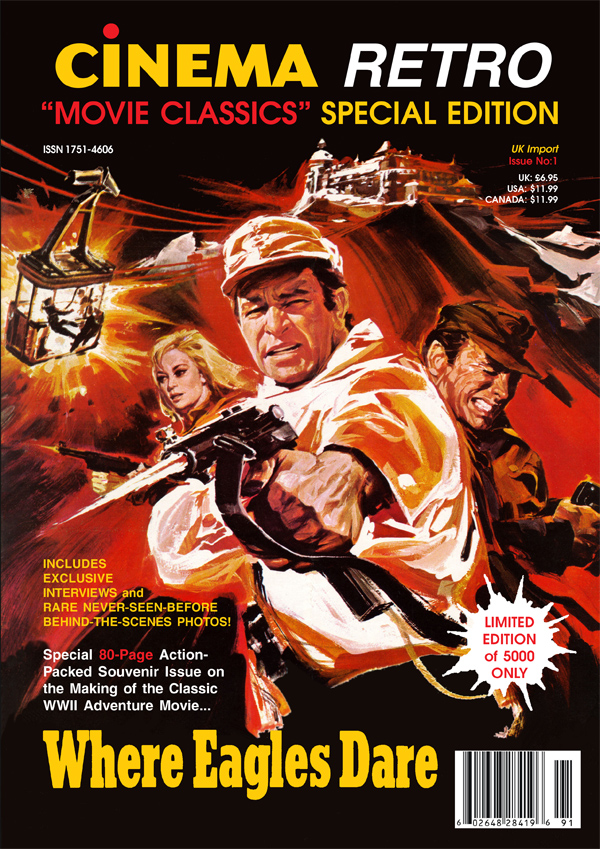 This article was written exclusively for Cinema Retro and appeared in a special "Movie Classics Special Edition" devoted to "Where Eagles Dare". This article was written exclusively for Cinema Retro and appeared in a special "Movie Classics Special Edition" devoted to "Where Eagles Dare".I promised Cinema Retro’s editor Dave Worrall I'd write an article about the technical details about "Where Eagles Dare" - the best war movie ever made. But, since I was too young to have experienced the original release myself, I have asked some good friends of in70mm.com to take you back in time, when cinema-going was an event and movies were something that sometimes could change your life. I'll give you some background first and then you can read their memories from the original release of "Where Eagles Dare". When I was a child in the 1970s there was one film I really, REALLY wanted to see. I didn't manage to see it, however, until I had turned 15. It was on 8 July 1978 at 4 o'clock in the afternoon to be exact - in 70mm at the 3 Falke Bio in Copenhagen, Denmark by that time almost 10 years after the initial Danish release. The film was "Where Eagles Dare", or "Ørneborgen" (Castle of Eagles) as it was called in Danish. I remember the adverts said "Strictly forbidden for children" (usually a film was "just" forbidden for children under 16. That "strictly" rating made me want to see the film even more. What a clever advertising trick by MGM's Danish marketing department). I have loved the film from that first viewing. The story, Ron Goodwin's music, the action, stereotypical Nazi bad guys, the actors, the photography, everything. I am always puzzled by Major Smith's talk in reel 4 about who is who and what is going on. My favourite is, of course, Derren Nesbitt's Nazi character Major von Hapen, who delights us with genuine talk about "Ze other Zide of ze square" - just hilarious. To this day, 31 years later, I can still watch the film, and still enjoy NOT being able to fully comprehend what is happening. That is a unique quality to this film. "WED" - as it is affectionally known among friends - has followed me for all these years, and I have seen it again and again many times. I have even introduced it to my children and wife, who all enjoy a truly spectacular film. It is a source of continuing entertainment. Twice we have even visited the spectacular filming locations in Austria. | More in 70mm reading: "Where Eagles Dare" - Cinema Retro ‘Movie Classics’ Special "Cinema Retro" - The Golden Age of Film Making Widescreen Weekend 2009, Bradford, England Widescreen Weekend 2003 report |
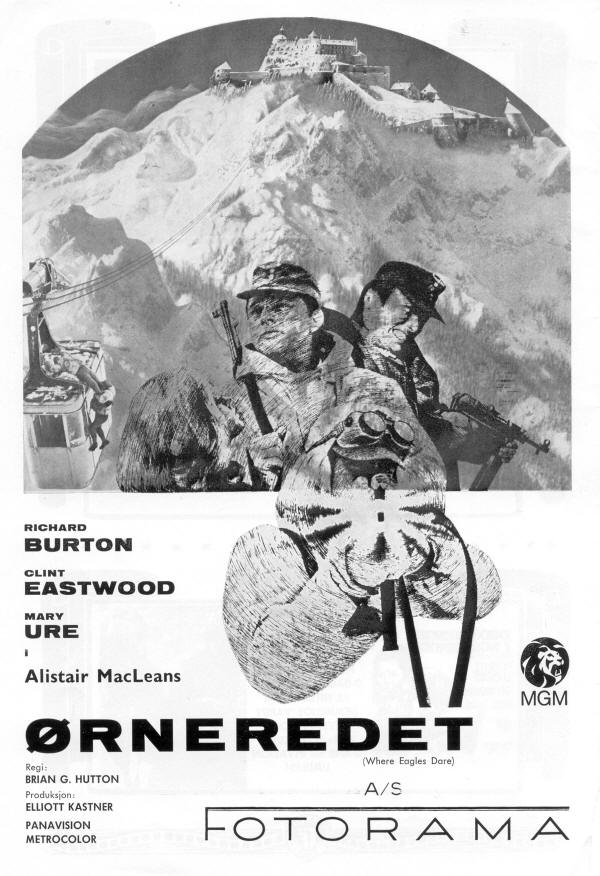 Advert from Norway Advert from Norway“Where Eagles Dare” was filmed on location in the Austrian Alps in the small villages of Lofer, Werfen and Fauerkogel by Ebensee. The castle Hoenwerfen was the main location where most of the castle exteriors were filmed. All interior scenes were filmed in Britain’s Borehamwood studios. The film was photographed by Arthur Ibbetson in 35mm with Panavision's anamorphic lenses. That means, he framed the images for an aspect ratio of about 2,35:1 - a screen picture width which would 2,35 times wider that the screen height. That was how "Where Eagles Dare" was shown across Europe during the original release. The soundtrack was 35mm mono, but the film was also available in 4-track stereo, which are 4 magnetic tracks placed on the film for stereophonic sound playback in cinemas do equipped. In Europe the film was also road-showed in the largest cinemas, which meant a release with 70mm prints and 6-track magnetic stereophonic sound plus an intermission, music and an entr'acte before the second half of the film. The 35mm negative film was optically enlarged (blown up) at Technicolor’s London plant with Panavision’s Micro Panatar printer lens to a 65mm interpositive, which was used to create a 65mm negative. The large 65mm negative was then used to print the 70mm release prints, a process used when a large number of 70mm prints were required. Finally, 6-track sound was recorded in real time on iron oxide magnetic strips placed near the edges of the film. It's very time consuming and expensive process, because the oxide has to be applied to the print and dried first. The European 35mm and 70mm prints were always roadshow versions with intermission. The Americans did not have the intermission, music or entr’acte and it was only given a very limited 70mm release in the US. "Where Eagles Dare" played in original English language version in Scandinavia, Holland, Belgium and many more. Most countries have their own translation and subtitling services capable of mechanically adding very small letters onto actual 35mm film prints. When projected, two white text lines of translated dialogue would appear at the bottom of the image on the screen. In the case of 70mm prints, only one company, Titra in Bruxelles, was able to add subtitles to 70mm prints. Once the titles were ready, a printed set of all subtitles for the entire film was sent to the local distributor, who had the responsibility of proofreading the text before they were etched into the 70mm print. Essentially, all 70mm prints for the entire European market had to go through Titra to have subtitles added. | Sheldon Hall, UK: WHERE EAGLES DARE had its world premiere on 23 Jan 1969 at the Empire, Leicester Square (it interrupted a run of the 70mm version of GONE WITH THE WIND). It was given a trade press preview in an unfinished state, without the music score, in the US in early December 1968. Rick Raskin, Manassas Virginia, USA: I saw it in 35mm 4-track magnetic in Pensacola, Fla. There was no intermission. 6 Feb 2009 Thanks for the Anniversary write up of "Where Eagles Dare" Sensational! I loved the photography and scenery on the giant screen as I remember when I was young. I was really interested in seeing wide screen 70mm and Cinerama prints of movies when they debuted in the big cinemas in the city. Luckily in 1960's and early 70's we had a heap of 70mm/ToddAO and one Cinerama cinemas in Auckland NZ where I grew up. I always liked war movies like Guns for Navarone, Das Boot, as well. Cheers, Mark |
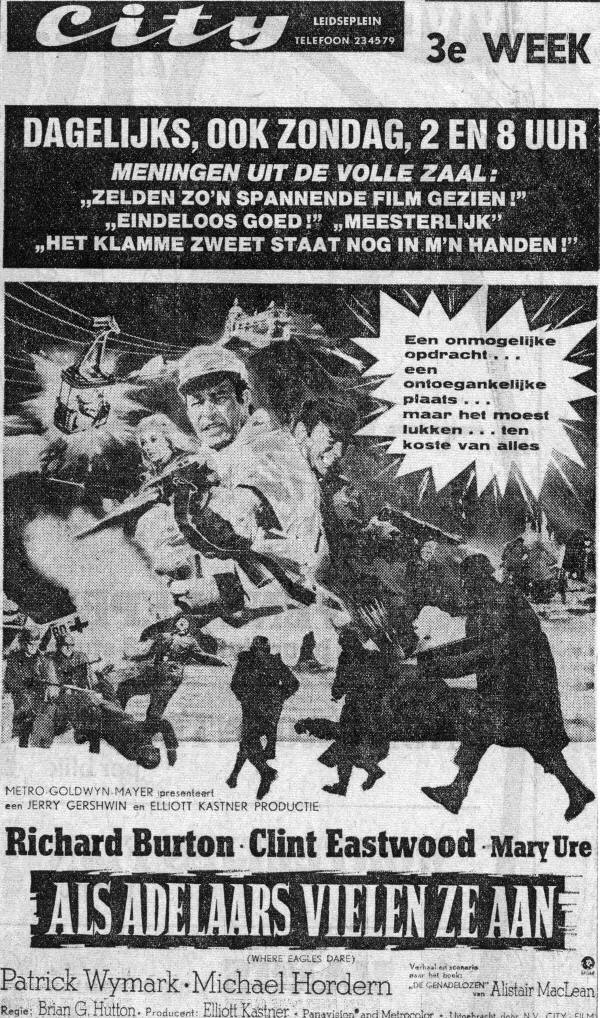 Advert from Holland Advert from HollandSome European countries have a tradition of "dubbing" English films into their own language. A highly skilled technique which is used in Germany, France, Italy and Spain to name a few. Dubbing means a local actor speaking the original lines in his own language, thus creating a German, Italian, Spanish or French version of the film. Usually the same actor dubs the same actor from film to film. To record the German version of "Where Eagles Dare", German actor Herbert Stass was hired to do record Clint Eastwood's voice, Richard Burton was dubbed by Holger Hagen, who was also Dean Martin and James Garner's German voice. Erich Fiedler dubbed Ferdy Mayne and Wilhelm Borchert dubbed Anton Diffring. When the re-dubbing was finished, a new dialogue track was re-mixed and used to make the film prints. The sound for any film is a combination of three different layers of sound: dialogue, music and effects. It is a fairly simple matter to exchange the original English dialogue track with any foreign language track to create the 35mm and 70mm prints for cinema exhibition. So "Where Eagles Dare" was available in both in 70mm and 35mm magnetic stereo version, and with original and foreign dubbed versions across Europe. In Germany it was retitled "Agenten Sterben Einsam" ("Agents Die Alone") and in Denmark, Norway and Sweden it became different version of "Ørneborgen" ("The Castle of Eagles"), "Ørnredet" + "Örnnästet" ("The Eagles Nest"). It was not released in all European countries. One example is the Czech Republic (known as Czechoslovakia at that time), where it was not released until 1989 because of ideological reasons. "Where Eagles Dare" was released on videotape in the early 1980s, and later released on LaserDisc. The LD included the full road show version with intermission. The later DVD version from 2003 was a disappointment, as it did not include the intermission. Hopefully a future Blu-ray edition will correct this oversight. In Sweden two guys have their own "Where Eagles Dare" internet page with a huge amount of interesting information. (www.whereeaglesdare.com has since closed) In recent years the film has received somewhat of a cult following, with 70mm presentations in London & Bradford (UK), Malmø (Sweden) and Karlsruhe (Germany). Very few 70mm prints have survived to this day, so it is indeed something to seek out if you want to see it it as it was originally presented: In 70mm on the big curved screen. | |
Life with "Where Eagles dare" | |
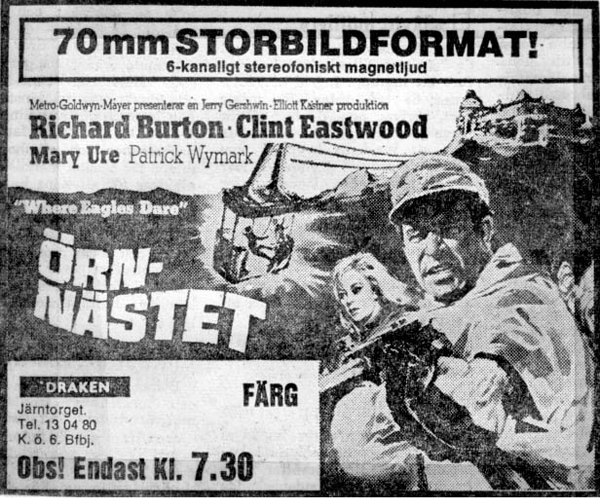 Advert from 1975 from Stefan Adler's archive. Advert from 1975 from Stefan Adler's archive.My life with "WED" began the first time I set foot in the booth at Draken in Gothenburg as a trembling high school teen, while learning how to be a projectionist. According to IMDB it was first released in Sweden January 23 1969, and that might just be right, 'cause my first visit to Draken's booth was in March and "WED" was still playing for sold out houses... Little did I know that "WED" would follow me throughout my entire career as a projectionist at Draken. The print shown was a 70mm 2,21:1 blow-up with sound on all the six channels, but not with the extremely discrete directional dialogue of the true 70mm productions. The image was fair, but far better than later 70mm blow-ups, probably since the most part of it was heavily darkened day-shots. The print was 8 reels, with a total length of 5192 meters. Throughout the entire run- and re-run period, which lasted for almost 20 years we played pretty much the same 70mm road-show prints (I think there were four of them altogether with Swedish subtitles). Reel 1 opened with the MGM lion and reel 5 closed with an Intermission (when Clint Eastwood has concealed dynamite throughout the conference room and leaves, closing the big doors with the final booby-trap), it was a fade-out and an Intermission card, while the theme played. Reel 6 opened with an entr'acte, with the snare drum ostinato and the theme for approx. 2,5 mins, a fade-in and the escape in the staircase sequence. Reel 8 closed with short end titles. The 35mm anamorphic prints also had intermission, and at least the 4 track magnoptical prints had the entr'acte. "WED" was one of Draken's big blockbuster hits. Before the tragedy of hectaplexes, DVD and cable TV, we were able to have more or less constant re-runs and it was actually never out of distribution. Of the total 51 70mm titles that played at Draken from 1966 (when the Cinerama gear was switched to 70mm) until I quit in 1988, "WED" was the most current and successful of the re-runs. It opened in 1969 and had re-runs in '72, '74, '75 '78, '80, '82, '84. None of the re-runs played less than 8 weeks. If I remember it right it also played one re-run at our other 70mm house, Victoria. When? Might have been '76 or '77? Talk about blockbuster! I must have done more than 1000 shows on that one. It's still in my blood - I seem to jump out of my chair whenever there is a changeover still to this day, when it occasionally plays on TV. • Go to The Passing of Stefan Adler • Go to The Swedish Widescreen Pages | |
The Panavision Micro Panatar | |
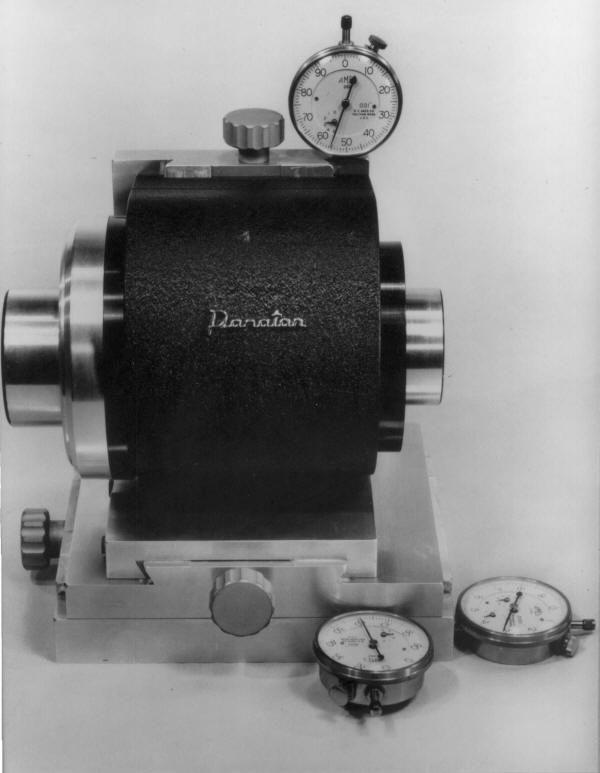 The Panavision Micro Panatar lens for making optical enlargements of 35mm films to 65mm/70mm film. Picture supplied by Tak Miyagishima, Panavision. The Panavision Micro Panatar lens for making optical enlargements of 35mm films to 65mm/70mm film. Picture supplied by Tak Miyagishima, Panavision.If my memory serves me correctly the blow-up was done in London and the printer lens that was used would've been serial number MP-133 since the record we have shows that the lens was placed there during that time frame. This printer lens unsqueezed the anamorphic 35mm image and then the lab printed it onto the 65mm negative. The anamorphic elements were - again, if my memory serves me correctly - 4 doublets (two pairs of prisms) with each pair set at a power of 1.414 (since 1.414 squared equals 2) and the actual printer lenses that were used were probably either 120mm and 150mm or 200 and 250 paired together as a set. These lenses would then magnify the 35mm image to the proper 65mm image (.700 height to .870 height). These values were the projection apertures of the 1969/1970 era. If you recall .700 was the standard height for 35mm projection apertures in those days rather than .690 image height of today. I'm forwarding you a picture of the printer lens that I'd scanned. I have the photograph on my office wall directly in front of me so that I can see it everyday. Keep in mind that the housing assembly that holds the printer was designed the same for every printer that we made. The only difference was the printer optics. Also the photo would show that the printer assembly was adjustable in three directions. That would be fore and aft, left and right, as well as the height. The micrometers were placed so that any minute adjustment could be made and noted. | |
Example of 35mm to 70mm enlargement (blow-up) process | |
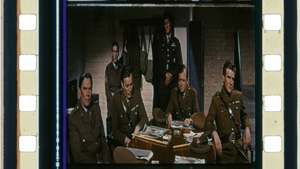 35mm mag-optical (magnetic/optical sound) print with Fox sprockets. 35mm mag-optical (magnetic/optical sound) print with Fox sprockets.In this interior scene from the beginning of the film, it is clearly seen that the image is "squeezed" in the horizontal axis from being filmed "in Panavision". The Panavision lens photographs the image with an anamorphic ratio of 2:1. Which means there is twice as much horizontal picture information than vertical information. People appear thin and tall. In the cinema when projected, a special lens is attached to the projector to un-squeeze the image and make the image appear normal on the screen. The anamorphic process is called Panavision, but other versions of the same basic process include, CinemaScope, TohoScope, WarnerScope, FranScope and a lot of other 'scopes. | |
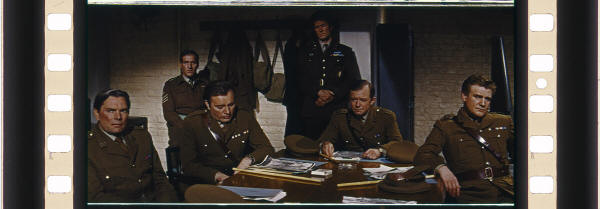 70mm magnetic print. 70mm magnetic print.This is the 70mm version of the same scene as optically enlarged with the Micro Panatar lens. It was common to enlarge the 35mm negative to full 70mm height, and there by lose some picture information on each side of the 35mm frame. See how this scene looks in 35mm with more image information compared to the 70mm version. Later blow-ups of anamorphic films (like "The Deer Hunter" and "The Untouchables") were enlarged to full 70mm width. Those prints had had thicker frame lines, but retained the original 2,39:1 anamorphic aspect ratio. The advantage of enlarging to 70mm was more light on the screen (from the large image), better picture steadiness and better and brighter colors. | |
Rick Mitchell, Hollywood, USA: | |
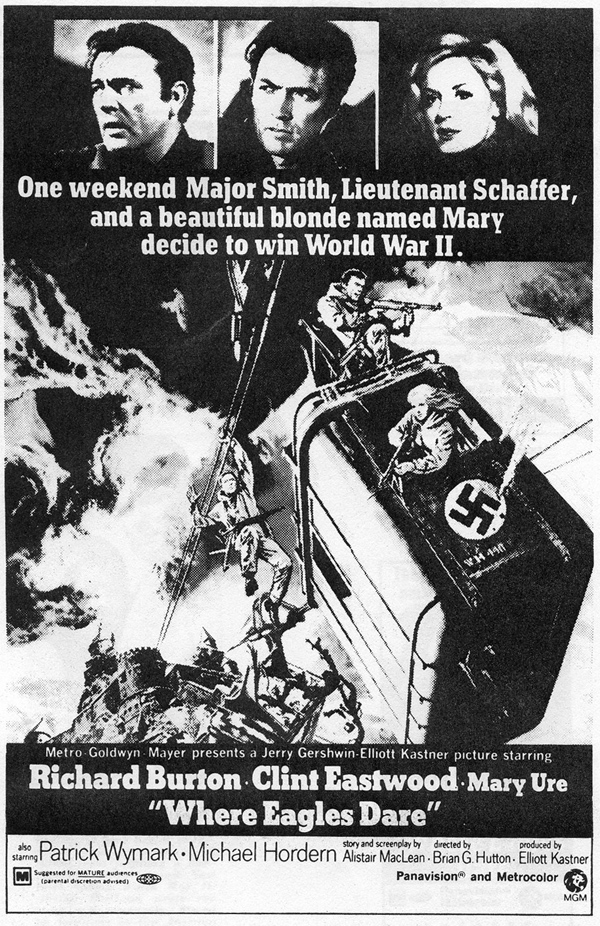 North American advert North American advertAs I recall, "Where Eagles Dare" was the first film released over here in a modified roadshow policy in which the film would open a month prior to its general release with 70mm prints in one theater in select theaters. The print I saw here, at the Paramount (now El Capitan), did not have an intermission, overture, or walk-out music. It probably played New York this way and possibly Chicago, but I don't know where else. After it's wider 35mm first run release, it was cut to 131 minutes for second run and actually didn't work as well as the 158 minute original version. The full version was used for the 16mm nontheatrical release; I know nothing about its fate on video. This modified roadshow policy came about because of the increasing failures of traditional roadshow films beginning in the fall of 1967, as well as the unexpected audience response to "2001", which MGM had been prepared to write off as a bomb because its advance ticket sales came nowhere near those of "Grand Prix", only to become a hit from young people buying tickets before individual shows. Over 1968, theaters began dropping the established trappings of roadshows: reserved seats, higher prices, two shows a day, etc. This new presentation format, which I believe was colloquially known as "special engagement", preserved the higher quality 70mm image, though applied to blowups only, in a single big movie palace at regular prices and showtimes, the idea being to still single out the film as having been something special when it went into general release and played those cities where it hadn't been shown in 70mm. As I recall, "Hello, Dolly!", "Ryan's Daughter", and "Patton" were the last films to be given the traditional roadshow release over here. There were some films which kind of fell between the two, having intermissions and two a day shows in some cities, like "Airport" and "Paint Your Wagon", but increasingly over the next couple of years, the release pattern was along the lines of "Where Eagles Dare". By the early Seventies, only Fox and Warners were doing such releases, usually only in LA and NY and using 70mm prints that were made for use in Europe where roadshowing was still commercially viable. | |
Mike Coate, Hollywood, USA: | |
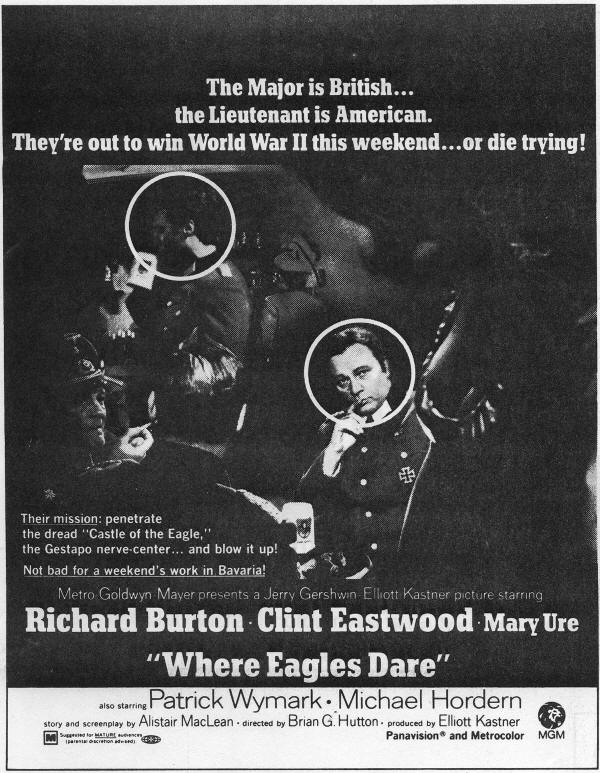 North American advert North American advertWhat I can tell you is that “Where Eagles Dare” was not released in the United States (in Los Angeles and New York at least) as a roadshow. From VARIETY's film review 9 December 1968: "The print shown [at the 3 December 1968 press screening at the Rivoli] in New York was a [158-minute] Super Panavision 70mm print, intended for the European market, complete with intermission, as it will be roadshown abroad. U.S. exhibitors will get the film in Panavision and without intermission." From a press release: MGM hosted a press junket and screening in Las Vegas, Nevada, 07-11 February 1969. The screening of the film was at the Cinerama Theatre on 08 Feb. In Los Angeles, the film opened exclusively on 12 March 1969 in 70mm at LOEW'S (now known as EL CAPITAN). In New York, it opened simultaneously in 35mm at ASTOR, MURRAY HILL and ORPHEUM. The promotional tag used for the L.A. run was: "In Spectacular 70mm" and "The Big Picture...The Big Stars! The One You Have Been Waiting For!" | |
 • Go to "Where Eagles Dare" - 40th Anniversary 1969 - 2009 | |
| Go: back - top - back issues - news index Updated 21-02-24 |
